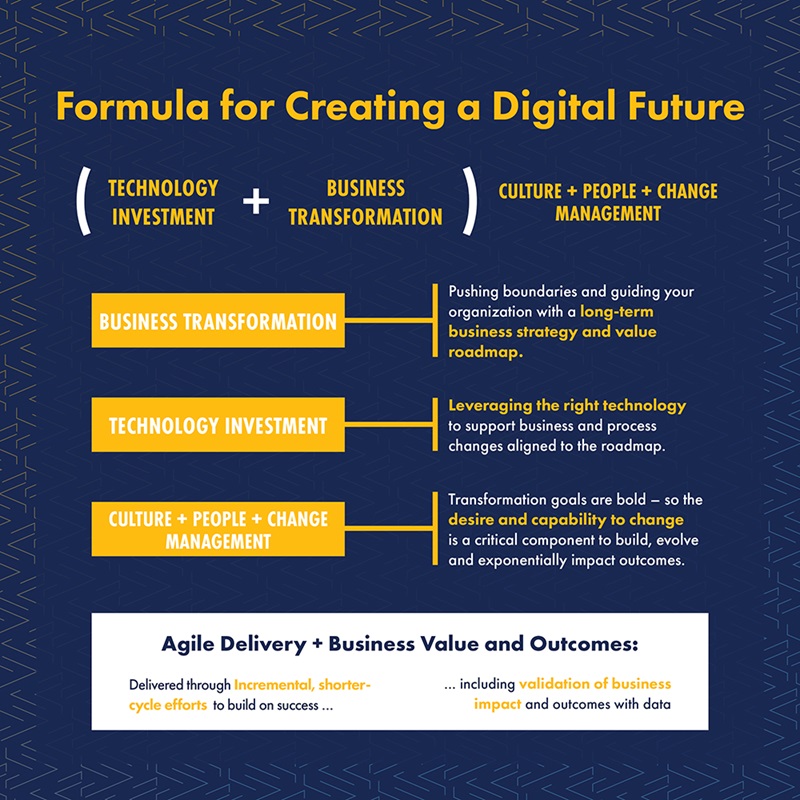Business and Technology Strategy Assessment

Organizations’ IT spend typically goes to daily operations: keeping the lights on, getting employees needed resources and ensuring continuity of service to customers.
It’s not easy to find room in the budget for expensive long-term projects that won’t have immediate, traditional ROI – even if a project promises substantial returns in the future.
However, when it comes to the project of digital transformation, there’s incredible urgency for organizations today. For most, it’s no longer a consideration; it’s a survival strategy. Customers expect digital, mobile and cloud-based experiences; remote work requires cloud-based, use-anywhere tools for collaboration; the power of analytics, artificial intelligence and automation are quickly lifting competitors’ capabilities, efficiencies and success with customers; and most organizations must find ways to optimize their people and processes so they can do more with less.
If you’re still fumbling with manual data entry and your customers don’t have multiple user-friendly channels to reach you through, you’re at risk of losing business, stakeholders and support. This is as true in how government services its constituents as it is with retailers interacting with their customers and nonprofit organizations communicating with their donors. If organizations delay transformation, they could lose customers and fall behind the competition, they won’t be as resilient against the unexpected, and they’ll miss out on the many benefits of advanced digital capabilities, automation and more.
IDC forecasts that direct digital transformation investments will be $6.3 trillion for 2022-2024. By the end of 2024, they will account for 55% of all ICT investments. And 53% of enterprise organizations already have digital transformation strategies in place, meaning that the leaders in your industry are already making strides to remain the leader.
For instance, organizations are capitalizing on data with real-time analytics, using them to optimize customer experiences, supply chain operations, demand forecasting and more. Having a grasp of such analytics and using them in real time keeps them ahead of the curve and dominant in their industries. When demand shifts or disruption occurs, they are better equipped to respond – faster and with data to inform their decisions.
Another transformational step big players are taking is moving primarily to “as-a-service” software models. Hosting their operations, communications and data in the cloud on a subscription basis enables them to scale when necessary, act on opportunities as they arise and tack on additional services without having to invest in on-premises hardware and additional staff.
Addressing the Financial Side of Transformation
If digital maturity is on the agenda, the opportunities may seem boundless. It’s easy to dream big and aim high when there’s so much potential. However, as a business leader, you know that with every initiative you consider, you must also address a key question:
How do I budget for it?
This is a loaded question for a topic as complex as digital transformation. It contains several sub-questions:
- How do I categorize investments related to digital transformation?
- How do I identify investments that align with my business goals?
- In what order should I invest?
- How do I measure the success of this type of investment?
- Do I have the capacity to transform in-house or would I benefit from consultant services?
If you’re asking these questions, you’re off to a great start. It pays to be thoughtful and strategic about digital transformation and to think of the process as an investment, as opposed to throwing Band-aid solutions at big-picture problems. It will help you avoid common failure points and be more successful.
Operational vs. Transformational Technology Investments
Often, organizations lump their transformational investments in as operational expenses. Moving forward, this perspective won’t suffice for these types of investments. It relegates them to categories that are too fixed for the purpose they’ll serve and for the cost structure they entail. Understanding the difference – and the importance of changing your budgeting perspective – will help you plan a more successful, meaningful transformation.
Operational technology investments keep your business in shape day-in and day-out. They answer a need or fix a problem. They aren’t necessarily part of a larger business strategy – but they can be.
An operational technology investment that is part of your digital transformation, however, should fall into a new category and be treated differently. We’ll call that category transformational technology investments.
A transformational technology investment is a technology or capability you pursue as part of your larger digital transformation strategy. It’s not about maintaining operations, it’s about investing in opportunity and change. Each investment is attached to a long-term goal and part of a strategy that fundamentally changes your business operations.
Budgeting and planning for such investments calls for different treatment than regular IT spending. These aren’t typical capital or operational expenses with fixed costs and expectations because the journey to transformation is not one-size-fits-all. Your transformation might call for a sizeable upfront investment, strategic investments over time or monthly costs that fluctuate based on your needs.
In other words: Your transformation budget must be flexible and agile. You must plan for a return on investment that evolves as you evolve your business and build your capabilities. And you must use new key performance indicators, along with traditional ones, to truly measure your success.
Types of Transformational Investments
To understand what to expect from your digital transformation budget, it helps to have an idea of what types of investments you might be looking at and how you can map out a flexible budget and plan.
Areas of focus we see clients prioritize in their digital transformation include:
![]() Agile Systems – Systems that are synchronized and enable your organization to deploy, respond, recover and grow in a timeframe that maximizes opportunity and reduces risk. For example, you’ll spend less time sitting on a project and more time reaping the rewards of having launched it. You’ll also be able to measure project performance and adjust it in a timely manner.
Agile Systems – Systems that are synchronized and enable your organization to deploy, respond, recover and grow in a timeframe that maximizes opportunity and reduces risk. For example, you’ll spend less time sitting on a project and more time reaping the rewards of having launched it. You’ll also be able to measure project performance and adjust it in a timely manner.
![]() Analytics – Insights that are pulled from your existing data and any additional data you choose to integrate, with which you can make organization-enhancing and -defending decisions that keep your operations healthy and profitable. With the right analytics tools to unify your data and well-built dashboards to help you easily view key insights, you can operate in real time and stay ahead of disruption.
Analytics – Insights that are pulled from your existing data and any additional data you choose to integrate, with which you can make organization-enhancing and -defending decisions that keep your operations healthy and profitable. With the right analytics tools to unify your data and well-built dashboards to help you easily view key insights, you can operate in real time and stay ahead of disruption.
![]() Cloud Infrastructure – An infrastructure by which operations, functions and data are hosted in a digital, cloud environment that is accessible from any location via an access-approved device and internet connection. Top cloud providers offer a high level of security and IT support, reducing the burden of IT on the organization. Real-time collaboration is achievable, and the organization can work off of the same, updated information at all times. Organizations may choose to maintain a certain level of functionality on-premises, resulting in a hybrid cloud infrastructure.
Cloud Infrastructure – An infrastructure by which operations, functions and data are hosted in a digital, cloud environment that is accessible from any location via an access-approved device and internet connection. Top cloud providers offer a high level of security and IT support, reducing the burden of IT on the organization. Real-time collaboration is achievable, and the organization can work off of the same, updated information at all times. Organizations may choose to maintain a certain level of functionality on-premises, resulting in a hybrid cloud infrastructure.
![]() Hybrid Work Capabilities – Secure communication and collaboration capabilities, as well as the tools and data employees need, delivered in a streamlined way. These capabilities must enable a workforce to be effective across geographies and devices while still providing work/life balance. This is now table stakes for a company to attract and retain talent, and it requires the right infrastructure as well as an understanding of best practice.
Hybrid Work Capabilities – Secure communication and collaboration capabilities, as well as the tools and data employees need, delivered in a streamlined way. These capabilities must enable a workforce to be effective across geographies and devices while still providing work/life balance. This is now table stakes for a company to attract and retain talent, and it requires the right infrastructure as well as an understanding of best practice.
Technologies that fall under these umbrellas include:
- Artificial intelligence (AI) and machine learning (ML): AI enables technology to “think” as a human would, ML enables the technology to learn from data independently.
- Mobile applications and capabilities: Software made accessible via mobile device and the abilities such software enables, such as remote work and collaboration.
- Automation tools and software: Technology that performs tasks in place of humans, whether physical or computational, as with programmed robotics or automated order processing.
- Internet of Things (IoT) technology: Devices, sensors and other technology that connects with the cloud to deliver data from a specific item or location, as with connected temperature sensors in logistics operations.
- Cloud-based accounting: A software-as-a-service model in which accounting capabilities and operations are accessible from anywhere, hosted in the cloud, which is scalable and secure and enables automation.
- Customer engagement and sales management platforms (CRM): Software that enables companies to manage customer relationships in one central location. Cloud-based CRMs today can help companies make the most of their data, improving their outcomes and expanding their customer base.
- Scalable integration solutions: Integration and workflow software that allow companies to leverage their existing technology investments in new ways to unlock value and achieve business goals.
- Data warehousing and visualization tools: Software and data storage that centralize your data, make it easier to pull relevant insights, and allow for those insights to be packaged into digestible visualizations.
The Cost of Digital Transformation
The cost of digital transformation is incredibly variable and will depend on the scope of what you want and need to do. It also depends on how you phase out your transformation and how broad or narrow your focus area is. You might take two steps this year and two steps next year; you might transform one division or the entire company. Additionally, your transformation won’t be a one-and-done project. For instance, the market may change, technology will evolve and new competitors will come on the scene, which will demand further transformation at your organization.
Making Transformative Decisions for Your Business and Budget
What’s important to focus on as you work through the cost of your unique transformation is the outcome. For what you put into your transformation, the value to your business must be exponential. As you map out your transformation and make critical decisions, always look through the lens of business value. Business value defines what an outcome of digital transformation will look like for you.
This means having a plan for where you want to go and being thoughtful about why and how. It means looking at your individual investments as part of a whole. Will this new, trending widget only solve a near-term solution when you could otherwise invest in three smaller, less glamorous initiatives that will improve your business for the long term?
A great digital transformation consultant will start with your desired outcomes. They’ll work to understand how your investments will evolve your business and the value, or return, you can expect if the transformation is well executed. A consultant will also use this information to help you avoid investing in dead-end roads, advising against decisions that don’t provide value in any way.
A consultant will also help you understand how to measure and ensure success in your transformation, an element of the process that is easy to de-prioritize in the whirlwind of change. Change management is as critical as any other part of the process. It’s the driver of this great new vehicle you’ve built. Measuring your progress and using change management to influence your outcomes and gain buy-in gets your transformation from point A, the past, to point B, the future state.
Keep in mind that there are more letters after B. The future is constantly escaping us and changing. Change management and digital transformation are both iterative processes which will need to be carefully tended and harvested to ensure success.
Taking these elements into account, we developed a formula for creating a digital future. It involves combining your business transformation, or expected outcomes, with the technology investment – then multiplying that by culture, people and change management. It’s the force of this multiplication that will drive your transformation and make your investments worthwhile.

Tips for Getting Started on Strategy
- Ensure your investments align to your business goals and a broader vision and strategy.
- Prioritize investments based on your roadmap, making sure you’re transforming where it will matter most.
- Don’t settle for lower-cost options – choose the best options for your business.
- Prepare to make the case for your investments and goals with data and roadmaps.
- Let your actual business needs and goals drive your choices, as opposed to trends and benchmarks in the industry.
- Determine relevant KPIs to use to measure the success of your transformation. Measuring success will be different for every business.
- Have a plan to facilitate change management at your organization – both initially and continually into the future.
- Ensure you have the right sponsorship within the organization to be successful with change management.
Why Put IT Spend Toward Transformation?
Your IT budget likely gets high demand and interest from multiple areas of your business. Why should it go to digital transformation? Because it can’t just go toward daily operations and maintaining the status quo if you want to compete and find success in this more digital era. You must allocate funding toward strategic, long-term transformation.
Strategy and Digital Future
Create a lasting digital future for your organization.

